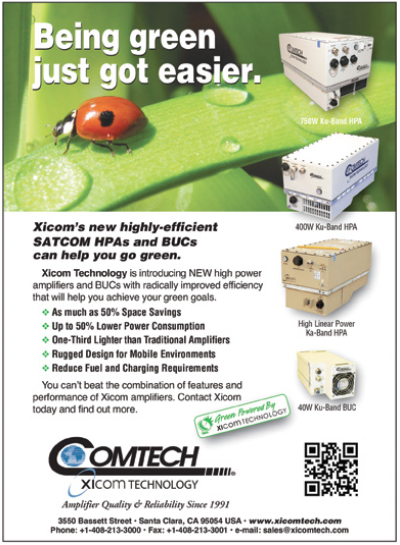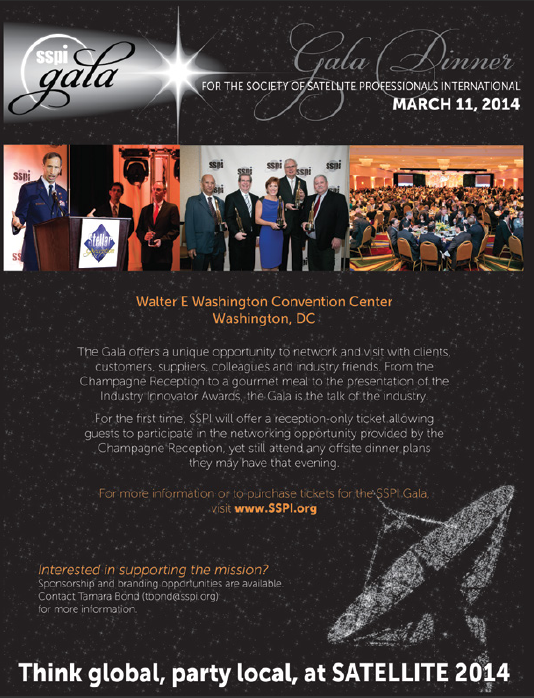The small solar-power sail demonstrator IKAROS launched in May 2010 has achieved all of its technological goals and is still cruising in the solar system. Its total flight distance as of June 2013 was about 3 billion km. Accelerated by solar radiation pressure, its velocity increment reached 400 m/sec over the three-year flight.
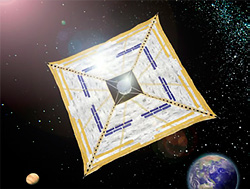
A small size powered-solar sail experimental spacecraft, “IKAROS”(Interplanetary Kite-craft Accelerated by Radiation Of the Sun)
—Image is courtesy of JAXA..
In this article, I look back at the research, development, and operation of solar-sail technology from the standpoint of my specialty, astrodynamics.
In view of my research background, I wanted to realize a solar-sail flight mission in outer space. First, I had to figure out how to make and deploy a solar sail. What awaited me at that time was a profound world of material, structural, and dynamic sciences.
Regarding deployment, from the start our research focused on using only centrifugal force generated by the rotation of the entire sail. Most other solar-sail researchers in the world use extendable sail trusses. In contrast, the centrifugal deployment system has merits such as lightweight structure and great flexibility in design and sail size. In addition, our choice of a different system from others is based on our strategic concept to bring originality to our research.
Our sail research emphasized understanding and control of deployment behavior. The sail must be very thin and large, so we inevitably face hard-to-predict wrinkling and folding.
Figure 1 at the top of the next column shows the transition profile of the strain energy (in this article, referred to as “internal energy”) stored in the wrinkles and folds of the sail at the centrifugal deployment event. Pattern A in Figure 1 shows ideal deployment, where the internal energy monotonously decreases by the effect of centrifugal force. In this case, the sail surely and fully deploys with the minimum energy.
Reality is not that simple, however. Other cases such as B and C in Figure 1 can occur easily. Case B is a fold pattern where a minimal point occurs during deployment, while case C shows an abnormality during dynamic deployment where exchange between kinetic energy and internal energy is too great. How can we realize an ideal deployment such as Case A? This was the question that we had to answer.
Very thin film flutters lightly with faint airflow in the atmosphere and hangs immediately and loosely in a gravity environment. The enemies of our experiment were air and gravity. In order to eliminate these two effects and verify sail deployment, we conducted numerous experiments in the first five years.
Our experiments included deploying the sail: By revolving it in a vacuum chamber, at high-altitude using a balloon, and in a revolving closed container. A critical step in our experiments was the successful centrifugal deployment of a 10m-class sail in space using the sounding rocket S-310-34 in 2004. In 2007, we also successfully deployed a 20m-class sail using a scientific balloon.
Feedback from these experimental results improved our numerical-simulation technology. Consequently, we established an environment where we could design large sail, which was too large to experiment, relying only on calculation.
The sail-folding method adopted for IKAROS was initially called the “Tsuda fold.” Later, various ideas from project members were incorporated and finally it was named “square-type sail.” Since its fold lines are all straight, this method has many advantages such as easy manufacturability and a good fit for centrifugal deployment. Its most popular feature is that it requires no cutting.
One of the beauties of Japanese origami (paper folding) is that it allows us to create various shapes without using scissors. Our folding method is entirely appropriate for Japanese solar sail technology. Thus, Japanese aesthetics also contributed to the selection of the sail-deployment method.
After the inauguration of the IKAROS project, a number of folding methods including the square-type sail were proposed. We founded two research groups, “sail structure group” and “sail material group,” with respective experts from inside ISAS and outside. They evaluated and examined various methods in detail from various aspects.
One candidate method showed a remarkable mathematical beauty far exceeding the square film. In order to select a single method, we scrutinized according to hundreds of evaluation criteria and had intensive discussions. It is my unforgettable memory (bad dream?) we had discussions all night through almost every week with experts joining the groups.
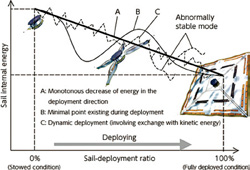
Figure 1. Profile of energy transition in centrifugal deployment
Development: Realization Of IKAROS As A System
To complete IKAROS as an exploration spacecraft system actually flying in outer space, we needed to overcome a number of challenges in addition to sail deployment. The reasons why such a small team could successfully complete IKAROS include: excellent communications between development team members, active and voluntary contributions outside their own specialty, and good teamwork based on strong trust with dedicated subsystem staff and hardworking manufacturing companies’ staff.
The biggest challenge of the spin-type solar sail as a navigation system is how to flexibly manage and control its angular momentum generated by the rotation of the large-area film. We had to solve the following problems:
(1) predict and manage wrinkles arising on the sail after deployment and the disturbance in solar-light pressure caused by the wrinkles; and
(2) control of the large angular-momentum and elastic sail to realize fuel-saving and keep it stable. Please refer to ISAS News, 2011 January edition (No. 358), for details on many technological ideas to solve problem.
Problem (1) was difficult. It is, in fact, impossible to predict what wrinkles would emerge on the flexible sail after deployment. Furthermore, the impact of the disturbance torque generated by solar-light pressure varied greatly depending on the shape and condition of the wrinkles. After the launch of IKAROS, a great discovery was made.
Operation: Discovery Of Spiral Motion
In addition to the structure and material groups, we initiated an “acceleration research group” to evaluate IKAROS’s solar-sail navigation after deployment. The group consisted of a dozen specialists and students in orbital mechanics from inside ISAS and outside.
The group examined solar radiation pressure acceleration performance based on data obtained from the actual operation. Further, it worked on a wide range of related research in solar-sail orbit, guidance, and navigation.
In solar-sail navigation, “orbital control” means control of the sail orientation and also attitude control. Understanding attitude motion is critical. The acceleration research group anticipated two properties of IKAROS’s attitude motion before launch: the “windmill effect” and “Sun-tracking property of spin axis.”
The windmill effect is a behavior where the spin rate changes as sunlight collides with the wrinkled sail surface. This is just like windmill rotation by receiving wind. The effect was observed immediately after IKAROS’s sail deployment.
On the other hand, the Sun-tracking property of spin axis is a behavior whereby light pressure on spin satellite causes the axis to track the Sun by plotting arc. Using this property, we can keep the spacecraft pointing at the Sun without fuel. This technique was used to help the asteroid explorer HAYABUSA when it lost fuel.
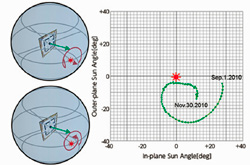
Figure 2. “Spiral Motion” of IKAROS Upper left: Originally predicted arc motion of spin axis Lower left: Spiral motion of spin axis Right: History of actual attitude of IKAROS
The attitude profile observed in actual IKAROS operation, however, was not an arc with a constant radius, but a “spiral” motion with gradually decreasing radius (please see Figure 2 above).
However, initially it was believed to be simply the difference between the ideal mathematical formula world and the real world. Since the phenomenon was very systematic, we discussed it intensively by examining formulae, even in the control room(!), while simultaneously operating IKAROS.
One month later, the acceleration research group came up with an answer to the mystery. The cause was wrinkles on the sail surface. The group showed a clear formula demonstrating the relationship between the wrinkle patterns and the attitude motion. The formula correctly suggested the spiral motion (lower left of Figure 2).
We immediately incorporated the new attitude-motion model into the operation system and revised the orbital and attitude-control plans.
The sail was originally designed to receive solar radiation pressure efficiently. Rather than considering the torque generated by light pressure as a disturbance, we had better to utilize it. By positively using spiral motion, we were able to prolong fuel storage more than twice as long as expected.
Our research on this phenomenon has advanced greatly, eventually enabling us to discuss the relation between solar-sail navigation performance and optical property distribution on the sail surface or the manageable accuracy of wrinkles (please see Figure 3 below). Thus, we are writing the world’s most advanced “design theory” for solar sail.
Before IKAROS, our research level was about the same as the rest of the world. Now, from our experience and data gained developing and flying an actual solar-sail vehicle, we have the most knowledge compared to any research team in the world. I believe the utilization of this knowledge will lead to superiority and originality of Japanese deep-space exploration.
In Conclusion
Currently, IKAROS’s attitude and orbital motion rely entirely on solar radiation pressure because of its fuel depletion. As its downlink signal is extremely faint because it lacks an onboard high-gain antenna, we are unable to conduct ranging to determine its orbit.

Figure 3. Wrinkles on the sail surface estimated by the spiral motion. Upper left: Real image shot by a deployable camera (DCAM) Lower left: 3D rendering result of shape motion Right: Sail shape estimated by attitude control (spin axis direction is shown exaggerated.
Thanks to the success of modeling the spiral motion, however, we can still predict IKAROS’s attitude and orbit correctly and obtain the data of its solar-sail navigation. We expect to continue to break records of light-pressure acceleration day by day and to operate IKAROS as long as possible.
IKAROS was a mission to perform a technological demonstration. With its success, we gained a foothold to travel to the outer-planet region far distant from the Sun.
Our next target is exploration of the Jupiter and Trojan asteroids. We will continue our research toward travel to this uncharted area, which must be made by the combination of large-area-film sail technology obtained through IKAROS and high-specific impulse ion engine.
I was delighted to receive the Fifth Space Science Encouragement Prize. This award honors the R&D activity of our entire team. Taking this opportunity, I would like to express my sincere thanks to all members of IKAROS development and research teams who have shared the same dream.
About the author
Yuichi Tsuda is the Assistant Professor of the Department of Space Flight Systems at the Institute of Astronautical Science, JAXA.
About JAXA
On October 1, 2003, the Institute of Space and Astronautical Science (ISAS), the National Aerospace Laboratory of Japan (NAL) and the National Space Development Agency of Japan (NASDA) were merged into one independent administrative institution to be able to perform all their activities in the aerospace field as one organization, from basic research and development to utilization. The independent administrative institution is the Japan Aerospace Exploration Agency (JAXA.)
Research and development in space and aviation areas as well as their wider applications are important means to achieve Japan’s policy targets, thus one of JAXA’s important missions is to contribute to solving various domestic and international issues.
2013 was an important year for JAXA as the organization celebrated its 10th anniversary—renewed was their corporate slogan, becoming “Explore to Realize.”
The 2014 JAXA brochure is available for download at http://www.jaxa.jp/pr/brochure/pdf/07/general07.pdf
About ISAS
ISAS has become one of seven principal sections within JAXA, with its mission to advance space science in Japan, mainly through collaboration with universities. ISAS also actively contributes to JAXA’s and Japan’s entire space development. ISAS focuses on the following activities: astronomical observations from outer space to study the structure and origin of the universe; solar system science to elucidate the history of the Earth and the solar system; use of space environment for microgravity experiments of various kinds; and space engineering to support these activities and pave the way for new possibilities in space.
The 21st century is the century when the human quest for knowledge challenges the new world - space. By challenging space, ISAS will make the greatest possible efforts to help Japan’s space science take another large step forward and to support JAXA’s great progress.
ISAS publishes a monthly magazine, ISAS News, which includes topics and regular activities at ISAS, serialized lectures on a variety of themes in space science and technology, space essays, and so on. ISAS News has a circulation of 3,000.
Additional information regarding ISAS is available at: http://www.isas.jaxa.jp/e/forefront/2013.shtml
Editor’s note
Our thanks to the Japan Aerospace Exploration Agency (JAXA) in allowing us to reprint Professor Tsuda’s article from ISAS News
(http://www.isas.jaxa.jp/e/about/public/public.shtml).
For further information regarding JAXA, their infosite is located at: http://www.jaxa.jp/index_e.html


